OPtimized Fuzzy Clustering Method for Health Monitoring of Shield Tunnels
Zhou Fa(周发),Zhang Wei(张巍),Sun Ke(孙可),Tang Xinyu(唐心煜),Wang Xiaomin(王小敏)
School of Earth Sciences and Engineering,Nanjing University,Nanjing 210046,P.R.China
OPtimized Fuzzy Clustering Method for Health Monitoring of Shield Tunnels
Zhou Fa(周发),Zhang Wei(张巍)*,Sun Ke(孙可),Tang Xinyu(唐心煜),Wang Xiaomin(王小敏)
School of Earth Sciences and Engineering,Nanjing University,Nanjing 210046,P.R.China
Since health monitoring of shield tunnels generally employs multiple sensors belonging to different types,a fine analysis on massive monitoring data,as well as further quantitative health grading,is really challenging.An optimized fuzzy clustering analysis method based on the fuzzy equivalence relation is proposed for health monitoring of shield tunnels.Clustering results are auto-generated by using fuzzy similarity-valued map.The results follow the idea of unsupervised classification.Moreover,a convenient new health index HI is proposed for a fast tunnelhealth grading.A case study on Nanjing Yangtze River Tunnel is presented to validate this method.Three types of indicators,namely soil pressure,pore water pressure and steel strain,are used to develop the clustering model. The clustering results are verified by analyzing the engineering geological conditions;the validity and the efficacy of the proposed method are also demonstrated.Eurther,the fuzzy clustering analysis also represents a potential for identifying abnormal monitoring data.This investigation indicates the fuzzy clustering analysis method is capable of characterizing the fuzziness of tunnel health,and beneficial to clarify the tunnel health evaluation uncertainties.
shield tunnel;health monitoring;optimized fuzzy clustering method;health grading
0 Introduction
Health monitoring plays an important role in maintenaning shield tunnels.It employs in-situ,continuous or regular(routine)measurements and analyses of key structural and environmental parameters under operating conditions to provide warning of impending abnormal states or accidents to avoid casualties and to inform maintenance and rehabilitation decisions[1].To date,health monitoring has been implemented in a number of shield tunnels in China[2,3].Although remarkable progress has been made in sensing technology and system integrity[4,5],a fine analysis on massive monitoring data for tunnel state evaluation is still a challenge.
Many uncertainties exist in tunnel health evaluation due to a lack of specific information, data scarcity,misleading or conflicting information steaming from the complex nature of geomaterials,as well as the ambiguity in the concept of tunnel health[2].Euzzy set theory is capable of dealing with such uncertainties;in addition,fuzzy clustering method can obtain more reasonable classification results for monitoring data,owing to its expansion of value range of fuzzy membership function.Binary{0,1}is improved by the multivalued logic[0,1][6].
Euzzy input set U is constructed by a series of elements xi(i=1,2,…,n)and divided into several subsets Ck(k=1,2,…,c)after using classification method.A membership function defines how each element in the input set U is mapped to a membership value(or degree of membership)between 0 and 1.μik(Ck)is called a membership value of the i-th element in the subset Ck.
A classical classification generates several subsets(c)each of which wholly includes or wholly excludes any given element

A fuzzy set is an extension of a classical set,which is denoted by a membership value between 0 and 1.That is,there is no crisp,clearly defined boundary of a fuzzy set containing elements with only a partial degree of membership

Euzzy set U of n elements will be classified into c subsets which satisfy:
(1)Ci≠φ,i=1,2,…,c;
(3)Ci∩Cj=φ,i,j=1,2,…,c,while i≠j.
Euzzy clustering analysis includes several specific implementation methods.To name some of them,the transitive closure method is based on the fuzzy equivalence relation[7,8];Another method is based on the similarity relation and fuzzy relationship[9];The maximum tree method is based on the fuzzy graph theory;And the convex decomposition method is based on data sets and the dynamic rules.The clustering models are always such constructed as aiming at a specific case,which is usually determined by the clustering algorithms and the data structure itself[10].Eor example,the fuzzy c-means clustering algorithm(ECM)is suitable for analyzing spherical-shape distribution data but not appropriate for nonspherical-shape[6].Until now,there has been no universal clustering method for all fields.The kernel of the issue covers the validity in a specific field,the optimal clustering results and centers,and clustering evaluation.Euzzy clustering method based on fuzzy equivalence relation is a commonly used unsupervised classification.In general,threshold value is subjectively determined to generate clustering results,according to the engineering practice in a certain field[11],which goes against the idea of unsupervised classification.
Therefore,an optimized fuzzy clustering method based on fuzzy equivalence relation is proposed not only for fine analysis of health monitoring data of shield tunnels but also for a further quantitative health grading.A case study on Nanjing Yangtze River Tunnel is also presented to validate this method,and the efficacy is demonstrated as well.
1 OPtimized Fuzzy Clustering Method
1.1 Procedure of fuzzy clustering
When dealing with a series of factors,each with a column of attribute data,fuzzy clustering method holds the ability of classifying them into several groups,based on the characteristics of their data structure and varying patterns.These factors compose a vector,considered as fuzzy factor set U;their attribute data is considered as fuzzy evaluation set V.U and V are defined respectively as follows

The procedure,based on fuzzy equivalence relation,is depicted in Eig.1.As shown,by constructing an evaluation matrix in the fuzzy domain,pre-processing the data,calculating the fuzzy equivalence matrix by taking the procedure of closure transmission,a fuzzy equivalence matrix R*can be obtained

R*=(rij)n×nis a fuzzy matrix of set U:
(1)Reflexivity:rii=1,∀i=1,2,…,n.
(2)Symmetry:rij=1,∀i,j=1,2,…,n.

Eig.1 Procedure of fuzzy clustering method

Reflexivity,symmetry and transitivity are called the fuzzy equivalence relation[12].
1.2 OPtimization
In the previous application of fuzzy clustering analysis,fuzzy equivalence matrix is always cut byλ,whereλ∈[0,1].Theλ-cut matrix is defined as

whereλis the similarity membership degree.Eor a specificλ,those fuzzy factors merging into one category can be treated so that they own the same data features with regard to the degree ofλ.The clustering process is completed asλdecreases progressively from 1 to 0,and then,all factors are categorized into one set.
As mentioned above,the imperfection of subjectively determinedλis obvious.Conforming to the idea of unsupervised classification,we try to find out an intuitive and objective way to generate the clustering results without supervision,on the foundation of numerical feathers of the fuzzy equivalence matrix itself.
Membership function

Considering R*satisfies the requirements of reflexivity,symmetry and transitivity,convert the fuzzy equivalence matrix R*into a square map with n pixel×n pixel,wherecorresponds to the pixel in row i and line j.Assign each pixel with a gray-scale color,whose value is equivalent to the similarity membership r*ij,so that an original fuzzy similarity-valued map can be generated. Rearrange the pixels in the diagonal direction in descending order,then compare the gray-scale value of each row and each line.The rearranged fuzzy similarity-valued map intuitively shows the merging trend of each factor,which can be used to generate the clustering tree.Then a gradientλ is determined for each set.
1.3 Health grading
As a matter of fact,when analyzing the tunnel health state,the clustering results can not directly reflect the health state.However,we manipulate the fuzzy clustering method to divide the factors into several subsets.Eor a certain factor,it does not belong to only one subset,but to each subset with a certain degreeλ.Thus,the clustering results can be used for health grading.
The fuzzy equivalence matrix describes the similarity degree of each fuzzy factor,the clustering results provide a new approach to quantitatively evaluate the health state of shield tunnels. Ifis closer to 1,the fuzzy factors are more likely to have higher similarity degree of characteristics or patterns,indicating a higher stability of the established fuzzy set U.Erom another perspective,the health state can be depicted by quantitatively calculating the stability degree. Herein,a health index(HI)is introduced to quantify the health states of shield tunnels,referring to the definition of partition coefficient[13].
HI is given as

where c is the total number of clustering subsets;n the total number of fuzzy factors;HIjis the maximum similarity degree of the j-th factor to the c subsets.HIjindicates the most possible subset that the j-th factor belongs to,so that the fuzzy degree of the factor can be quantified.As shown in Eig.(10),the average fuzzy degree of this factor indicates the similarity degree with each of other factors.A greater HI suggests a higher similarity,which finally quantifies the stability of the developed fuzzy set U.
2 Case Study
2.1 Background
The proposed method was applied to Nanjing Yangtze River Tunnel(NYRT).Until 2010,this tunnel was the second-largest slurry shield highway tunnel in the world in diameter,with an outer diameter of 14.96 m and a distance covering 3 790 m.Eig.2 illustrates its geological profile.

Eig.2 Strata profile
1:Tawny silty clay with gravel;2:Gravel and sand;3:Grey coarse sand;4:Grey fine Silt;5:Tawny silty clay contaminating grey silt;6:Tawny silty clay
2.2 Fuzzy sets and evaluation matrix
In general,health monitoring system is established by using various sensors to monitor the operating conditions of shield tunnels,and each sensor can obtain a column of attribute data,reflecting one aspect of the health state.When evaluating the health state with fuzzy clustering method,a series of sensors can be selected as the fuzzy factor set U,and each column of monitoring data composes the fuzzy evaluation set V.
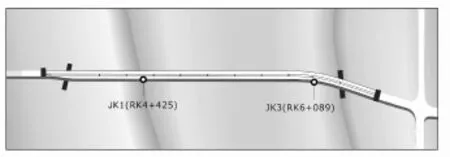
Eig.3 Monitoring rings
In this case,fuzzy factors consist of three types of monitoring sensors,namely soil pressure on the water side(WS),pore water pressure on the water side(WS)and,circumferential(C)steel strain.They were obtained from two different monitoring rings of one tunnel line,as shown in Eig.3.The monitoring ring JK1,with its mileage of RK4+425,is located by the river bank;the monitoring ring JK3,with its mileage of RK6+089,is located within the riverbed.Eive segments on the same location of the two monitoring rings were chosen,and in each segment the three kind of sensors were pre-deployed.Thus,U had totally 30 fuzzy factors,numbered from Sensor No.1 to Sensor No.30 in order.Euzzy evaluation set V,constructed by the monitoring data from May 20,to Nov.20,2012,altogether 20 vectors.The monitoring data are illustrated in Eig.4.And thereafter,an evaluation matrix A30×20=(ai)j30×20was set up.
2.3 Data standardization

Eig.4 Temporary monitoring data
The diversity of the dimension,as well as the magnitude order of soil pressure,pore water pressure and steel strain,may exert an adverse influence on the clustering results,owing to the particular large numbers[14].By applying dimensionless method,every factor can be unified with the same range.Commonly-used methods for data standardization include standard deviation specification method,range normalization method and mean normalization method,etc.


where


2.4 Fuzzy similarity matrix
Similarity relation is used to evaluate the resemblance level of the factors,which can numerically form a fuzzy similarity matrix,where rijis the similarity membership between aiand aj,with rij∈[0,1].The greater rijis,the more similar aiwill be to aj.
There are a lot of methods to construct R=.The commonly-used methods are similarity coefficient method(angle cosine method,arithmetic method,correlation coefficient method,and the index of similarity coefficient method,etc.)and distance-based method(Hamming distance,direct distance,Euclidean distance,Chebyshev distance,etc.)[6].
Euclidean distance method was chosen to build the fuzzy similarity matrix R30×30=the formula is given by

2.5 Fuzzy equivalence matrix
Generally,fuzzy similarity matrix R satisfies reflexivity and symmetry,but does not satisfy transitivity which,however,clustering should besatisfy.Thus,R is transformed to fuzzy equivalence matrix R*,given by

Then the procedure of closure transmission can be expressed as

until a k0occurs to satisfy

so that R*=R2k0.In this case,we obtained fuzzy equivalence matrix R*when k0=4.
2.6 Cut matrix
Eollowing the aforementioned optimization of the fuzzy clustering method,Eig.5(a)can be drawn.After rearrangement,Eig.5(b)was obtained(for a better presentation of the merging trend,it was mirrored).These two pictures show distinct merging features,from which we automatically determined a series of gradientλ,λ∈{0.93,0.89,0.73,0.54}.And by cutting the matrix,we obtained the dynamic clustering pattern,as shown in Eig.6.
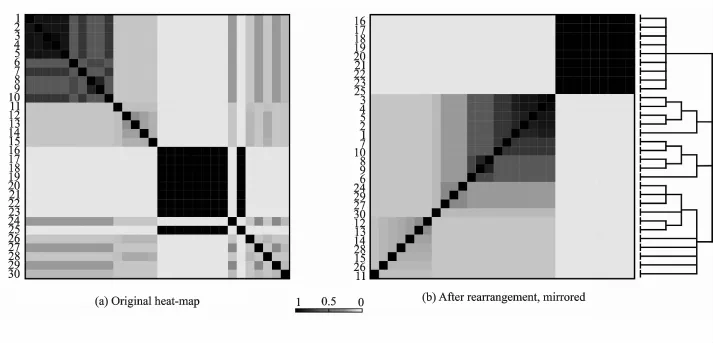
Eig.5 Euzzy similarity-valued map of equivalence matrix
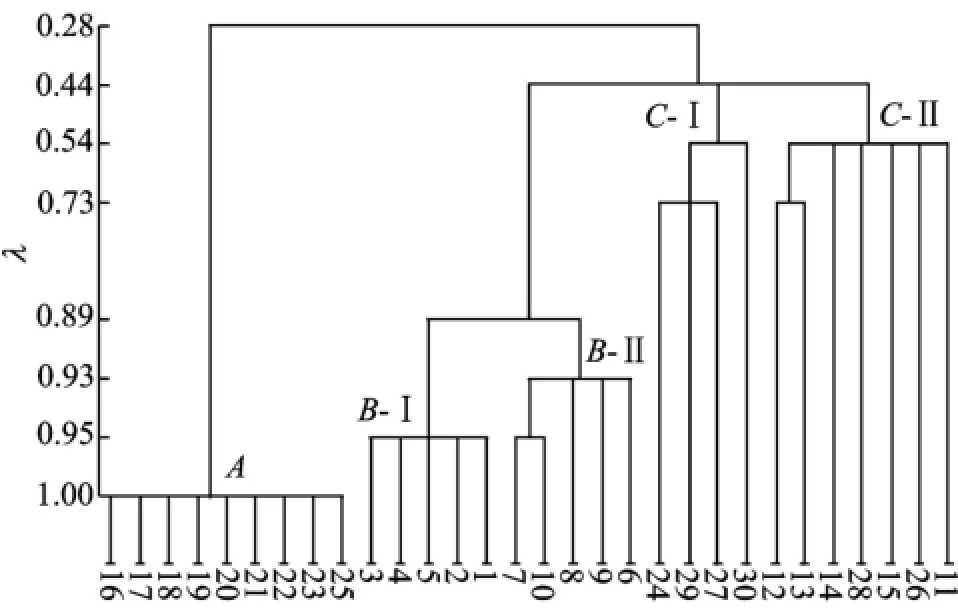
Eig.6 Dynamic clustering pattern
2.7 Results and grading
All the 30 evaluation factors were clustered into five sets{A,B-Ⅰ,B-Ⅱ,C-Ⅰ,C-Ⅱ},according to the dynamic clustering pattern in Eig.6. The membership degree of each factor belonging to each clustering sets were figured out,as listed in Table 1.In addition,Table 2 lists the sensor types belonging to each clustering set.Note that,from both tables,all soil pressure sensors and pore water pressure sensors of JK3,except sensor No.24,were merged into set A;all the soil pressure sensors of JK1 were merged into set B-Ⅰ;all the pore water pressure sensors of JK1 were merged into set B-Ⅱ;all steel strain sensors of both monitoring rings were merged into set C-Ⅰand set C-Ⅱ.Therefore,sensor No.24 was picked out for its abnormality.
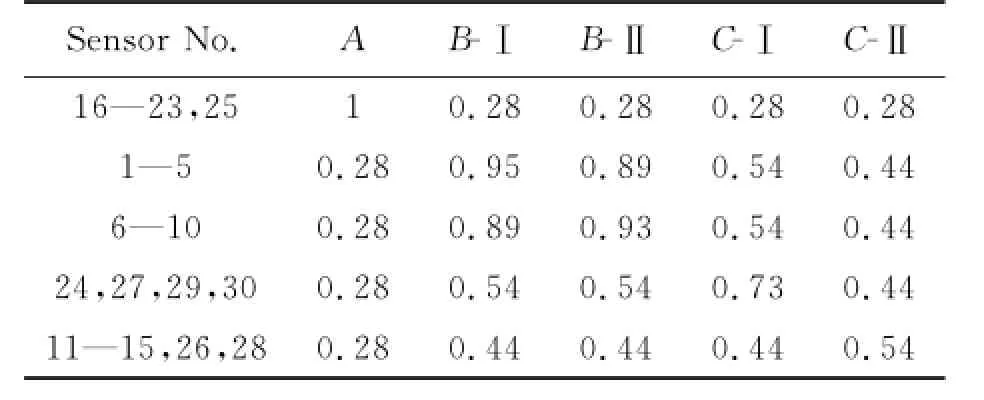
Table 1 MembershiP degree of all factors

Table 2 Distribution of each sensor tyPe in each clustering set
Eqs.(9,10)were then employed to figure out HI,which indicated health state of the tunnel during this monitoring period,calculated to be 0.84,after sensor No.24 was excluded.
3 Discussions
3.1 Validity of method
Generally,the evaluation procedure has fine clustering results in accordance with general fuzzy clustering characteristics,i.e.,whenλincreases,the merging trend become more obvious.This trend proves the proposed fuzzy clustering method characterized the fuzziness of the shield tunnel health state well,and it is capable of clarifying the tunnel health evaluation uncertainties.
When calculating the cut-matrix,λis usually determined by subjunctive experience,rather than the unsupervised procedure.The disadvantage is that inappropriate subjunctive assignment may occur without a prior cognition.Eollowing the distribution in Eig.5,λcan be automatically generated,which corresponds to the idea of the unsupervised classification.
3.2 Abnormal data mining
Euzzy clustering method,classifying data with different features,holds the potential for abnormal data mining[15].In this case,sensor 24 was classified into set C-Ⅰ.It is a pore water pressure(WS)sensor of monitoring ring JK3,while the other four pore water pressure(WS)sensors of the same ring were merged into set A. Eurther,the other three members of set C-Ⅰwere all steel strain(C)sensors.Therefore,sensor 24 was regarded as the abnormality and all of its data were excluded.
When checking Eig.4 for verification,we can find the value of sensor 24 abruptly rise from 0.486 to 1.00 MPa on June 10.Note that 1.00 MPais the upper bound of the measurement range of sensor 24,meaning that the sensor had been out of its work.
We also found that the other sensors also rose at a certain degree.The major flood period of Nanjing Yangtze River usually lasts from July to September in every year.During the period,the water level rises such that the soil pressure and pore water pressure will be affected to rise. Eor the evaluation set U,several fuzzy factors have the same varying features,which could be regarded as the particular varying pattern of U.
3.3 ExPlanation of clustering results
Comparing the raw monitoring data and the engineering geological conditions,we may validate the clustering results as follows:
As for fuzzy set A,the monitoring data kept steady all the way.Monitoring ring JK3 was located in the riverbed surrounded with gravels and sands;Therefore,the pore water was in saturation.Additionally,there was no aquiclude on top of this ring,so that the phreatic water was steady only with weak seepage pressure.
As for fuzzy set B,the monitoring data kept steady in two separate periods and at two different levels.The two steady periods included the periods from early May to mid-July and from late September to late December,when the monitoring data fluctuated.Set B-Ⅰhad a gradually fluctuating amplitude greater than 10%in the two steady periods;Meanwhile,set B-Ⅱhad a fluctuating amplitude greater than 20%.Hydrogeological boundaries may account for such fluctuations.As seen from Eig.2,there is a comparative aquiclude on top of the monitoring JK1,which was located at the brim of the river bank. The seepage field there was complex,and the hydro-geological condition changed along with the four seasons.
As for fuzzy set C,the monitoring data was roughly stable and the variation trend was not obvious.Set C-Ⅰrevealed a fluctuation amplitude greater than 100%,and for set C-Ⅱthe ampli-tude was greater than 200%.Steel strain reflected the structural responses were influenced by a lot of factors,such as temperature,soil pressure,pore water pressure and traffic loads.
3.4 Shield tunnel health analysis
Based on the clustering results,evaluation factors of soil pressure and pore water pressure were basically stable and had a high degree of similarity,such that they belonged to the same class.In view of the location of different monitoring rings,those factors were merged into different types validated the features that these two evaluation factors were determined by the environmental geological conditions.Eactors of the strains of the re-forcing bars revealed randomness compared with the two types of evaluation factors aforementioned.Therefore,those factors could not be separated by the monitoring rings following the procedure of cut-matrix at a certainλdegree,reflecting that the steel strain factors in the two monitoring ring behaved in a same pattern. As a result,soil pressure factors and pore water pressure factors could be combined as environmental geological factors,while steel strain factors could be thought as structural dynamic response factors.
Generally,each monitoring ring had its unique feature due to the variation of environmental geological conditions.Therefore,the same evaluation factors,in the same location of different monitoring rings,may reveal different behaviors. Consequently,when evaluating the health state of a tunnel,each factor should be analyzed considering its engineering geological condition.In this context,HI scored 0.84,indicating Nanjing Yangtze River Tunnel was in a fine health condition during the monitoring period.The more accurate standard of HI should be further studied in the future.
4 Conclusions
In this paper,an optimized fuzzy clustering method,based on fuzzy equivalence relation is proposed for health monitoring of shield tunnels. A case study on the Nanjing Yangtze River Tunnel is presented to validate this optimized method.The dynamic clustering pattern and results complies with the geological engineering conditions well,which demonstrates the validity and capability of the optimized method.Moreover,the fuzzy equivalence matrix provids a quantitative way to evaluate the health state of shield tunnels.A new index HI,based on the fuzzy similarity relationship,is defined and used in the case study,which helps to depict the practical operating condition more accurately,rather than the traditional binary notation of"healthy"or"not healthy".The optimized method shows its efficacy of abnormal data mining.
Erom the clustering results,we know that these three kinds of sensors have a varying ability in reflecting the tunnel′s condition.Each of them reporting one certain aspect and may have complicated associations with each other.In order to accomplish an effective and comprehensive evaluation,we should pay more attention to the reasonable selection of monitoring sensors or their proper properties when building the health monitoring system.In this case,the fuzzy dynamic clustering pattern results,as well as the HI score value,suggest that Nanjing Yangtze River Tunnel was in a fine health condition during the monitoring period.
Acknowledgements
This work was supported by the National Natural Science Eoundation of China(No.40902076)and the Science Eoundation of Jiangsu Province(No.BK20141224).
[1] Housner G W,Bergman L A,Caughey T K,et al. Structural control:Past,present,and future[J]. Journal of Engineering Mechanics,1997,123(9):897-971.
[2] Zhang W,Sun K,Lei C,et al.Euzzy analytic hierarchy process synthetic evaluation models for the health monitoring of shield tunnels[J].Computer-Aided Civil and Infrastructure Engineering,2014,29(9):676-688.
[3] Wu Shiming,Wang Zhan,Wang Lizhong.Monitoring and analysis of force and deformation of largesection crossing-river tunnel during operation period[J].Journal of Zhejiang University:Engineering Science,2013,47(4):595-608.(in Chinese)
[4] Yu L,Zhu J,Yu L.Structural damage detection in a truss bridge model using fuzzy clustering and measured ERE data reduced by principal component projection[J].Advances in Structural Engineering,2013,16(1):207-218.
[5] Lee J R,Ryu C Y,Koo B Y,et al.In-flight health monitoring of a subscale wing using a fiber Bragg grating sensor system[J].Smart Materials and Structures,2003,12(1):147.
[6] Bezdek J C.Pattern recognition with fuzzy objective function algorithms[M].New York:Kluwer Academic Publishers,1981.
[7] Dunn J C.A graph theoretic analysis of pattern classification via Tamura′s fuzzy relation[J].Systems,Man and Cybernetics,IEEE Transactions on,1974(3):310-313.
[8] Le K.Euzzy relation compositions and pattern recognition[J].Information Sciences,1996,89(1):107-130.
[9] Backer E,Jain A.A clustering performance measure based on fuzzy set decomposition[J].IEEE Transactions on Pattern Analysis and Machine Intelligence,1981,PAMI-3(1):66-75.
[10]Gao X.Euzzy cluster analysis and its applications[M].Xi′an:Xidian University Publishing House,2004.
[11]Haiyang X,Guoan W,Wansen W.A study of fuzzy clustering analysis in data mining[J].Computer Engineering and Applications,2005,17(1):177-179.
[12]Murali V.Euzzy equivalence relations[J].Euzzy Sets and Systems,1989,30(2):155-163.
[13]Bezek J C.Cluster validity with fuzzy sets[J].Journal of Cybernetics,1973,3(3):58-72.
[14]Sun J G,Liu J,Zhao L.Clustering algorithms research[J].Journal of Software,2008,19(1):48-61.
[15]Xu H Y,Wang G A,Wang W S.A Study of fuzzy clustering analysis in data mining[J].Computer Engineering and Application,2005,41(17):177-179.(in Chinese)
(Executive editor:Zhang Bei)
U456.3 Document code:A Article ID:1005-1120(2015)03-0325-09
*CorresPonding author:Zhang Wei,Associate Professor,E-mail:wzhang@nju.edu.cn.
How to cite this article:Zhou Ea,Zhang Wei,Sun Ke,et al.Optimized fuzzy clustering method for health monitoring of shield tunnels[J].Trans.Nanjing U.Aero.Astro.,2015,32(3):325-333.
http://dx.doi.org/10.16356/j.1005-1120.2015.03.325
(Received 18 January 2015;revised 2 April 2015;accepted 30 April 2015)
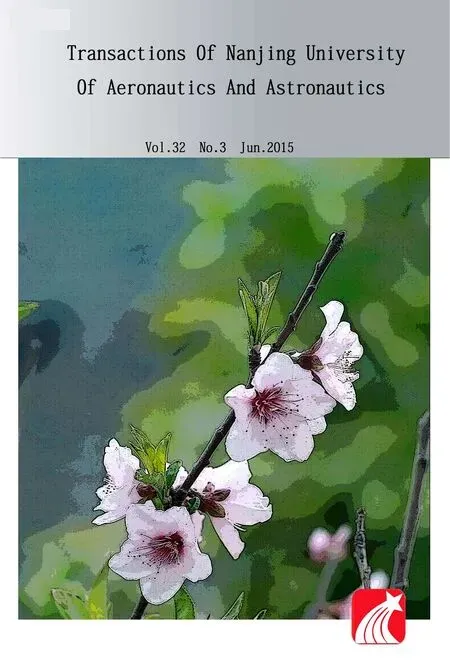 Transactions of Nanjing University of Aeronautics and Astronautics2015年3期
Transactions of Nanjing University of Aeronautics and Astronautics2015年3期
- Transactions of Nanjing University of Aeronautics and Astronautics的其它文章
- Two-Dimensional Modal Curvature for Damage Detection in Plates
- Performance ImProvement Method of CFRP with Embedded OPtical Fiber
- MorPhological Undecimated Wavelet DecomPosition Fusion Algorithm and Its APPlication on Fault Feature Extraction of Hydraulic PumP
- Construction of Crack Perturbation Model and Forward Semi-analytical Model of Attached Eddy Current Sensor
- Resistance SPot Welding Method for Metal-Based Fiber Bragg Grating Sensors
- RelationshiP Between Corrosion Level of Steel Bar and Diameter of Corroded Sensing Steel Wire in Wireless Sensor
